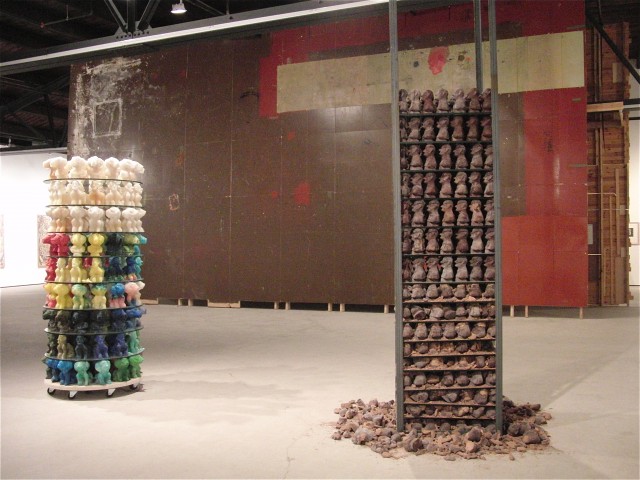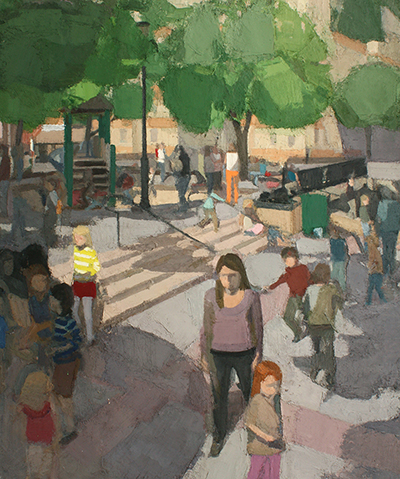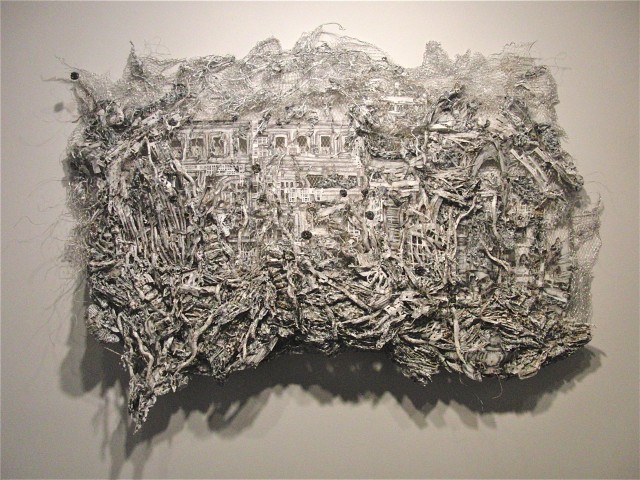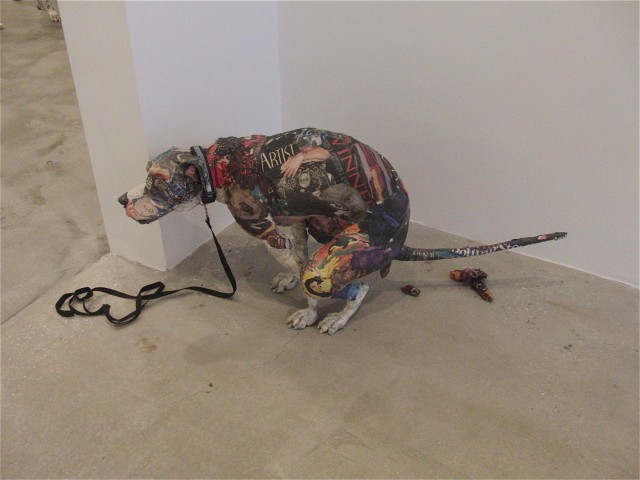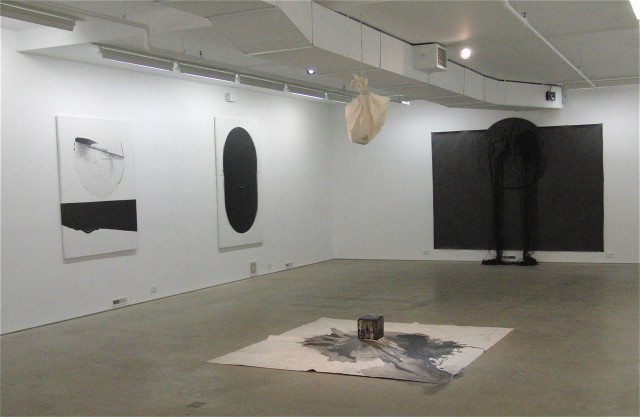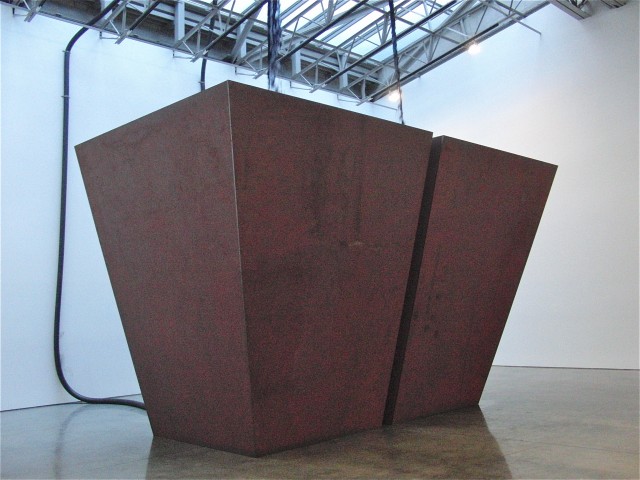On the fifteenth anniversary of his death at age sixty-eight, the work of eclectic German-born Swiss artist Dieter Roth and his son inaugurates Hauser & Wirth’s vast new space on West Eighteenth St. while also celebrating the gallery’s twentieth anniversary. “Dieter Roth. Björn Roth” (through April 13) includes paintings, assemblages, and installations using such objects as chocolate, bananas, sugar, toys, and Dieter’s actual clothes. Organized by Dieter’s son, Björn, and grandsons, Oddur and Einar, the exhibit also features 128 monitors showing Dieter at work, a tower of colorful sugar figures, another tower of chocolate figures that are slowly degrading, the floor from Dieter’s Iceland studio, a kitchen loaded with myriad objects, and a bar that serves free espresso on set days.
In “John Dubrow: Recent Work” (April 20) at Lori Bookstein, the Massachusetts-born, New York City-based painter once again displays his marvelous skill and astonishing facility with color in a series of outdoor scenes along with three portraits. Dubrow often applies paint thickly with a palette knife, blurring faces in such canvases as “Church and Reade,” “Standing Playground, Early Summer,” “Bleecker Playground,” and “Hudson River Park,” incorporating areas of reds, blues, greens, and yellows that are worth examining up close.
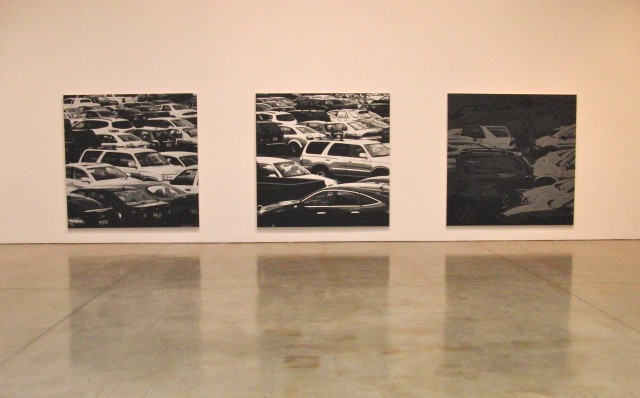
Wayne Gonzales takes multiple views of a California parking lot in compelling new series (photo by twi-ny/mdr)
For the eponymous “Wayne Gonzales” (April 27) at Paula Cooper, the New Orleans-born, New York City-based artist explores a California parking lot in photorealistic acrylic paintings that go from black-and-white to blue, gray, and deep yellow, zooming in and out of focus on cars, playing with time and space as he depicts the same area from just a slightly different angle or distance, some of the cars still there, others gone and replaced by new ones.
![Helen Frankenthaler, “Untitled,” oil and enamel on canvas, 1951 (© 2013 Estate of Helen Frankenthaler/Artists Rights Society [ARS], New York)](https://twi-ny.com/wp-content/uploads/2013/04/helen-frankenthaler-e1365509468149.jpg)
Helen Frankenthaler, “Untitled,” oil and enamel on canvas, 1951 (© 2013 Estate of Helen Frankenthaler/Artists Rights Society [ARS], New York)
Last week, the line ran nearly the length of Twenty-Fourth St. between Tenth & Eleventh Aves. to get a last look at Gagosian’s terrific “Jean-Michel Basquiat” exhibition. This week you should expect long lines for the final days of the revelatory “Painted on 21st Street: Helen Frankenthaler from 1950 to 1959” (April 13) at Gagosian’s Twenty-First St. space, comprising nearly thirty works that shed light on an extraordinary decade in Frankenthaler’s career. Curated by MoMA’s John Elderfield, the show features such energetic and lovely paintings and stained canvases as “The Jugglers,” “Open Wall,” and the spectacular title work, which deservedly greets visitors on its own wall by the entrance. A native New Yorker, Frankenthaler, who died in 2011 at the age of eighty-three, left behind a unique legacy highlighted by her own take on abstract expressionism.
In “Duality of Matter” (April 13) at Von Lintel, Israeli-born artist Dana Melamed creates miniature ghostlike scenes that hang on the walls, sculptures made of transparency film, paper, pencil shavings, charcoal, wire, acrylic paint, recycled industrial components, and aluminum mesh on which Melamed, who lives in New Jersey and works in New York City, uses a blowtorch. The resultant pieces are like abandoned ghost towns that combine construction and deconstruction, examining, in Melamed’s words, “human aggression towards humanity and towards nature.”
Making our way through Will Kurtz’s “Another Shit Show” (April 27) at Mike Weiss reminds us of heading across East Thirty-Fifth St. every morning, navigating between dog droppings that negligent canine owners have carelessly left on the sidewalk. The Brooklyn-based artist’s second solo show centers on “Linda the Dog Walker,” an old hippie woman walking a half dozen pooches in the back of the gallery, which is filled with more than a dozen other dogs as well, each made of wood, glue, wire, and carefully chosen newspaper articles.
Takesada Matsutani, who is represented in the Guggenheim’s truly splendid “Gutai: Splendid Playground” exhibition, is currently also enjoying his first U.S. retrospective, “Gutai Spirit Forever: Part 2, Works from 1977-2012” (April 20) at Galerie Richard. The second half of the show features abstract, monochromatic works from the last thirty-six years in addition to a central installation in which graphite drips onto a block and cloth on the floor.
There’s a beautiful sound emanating from behind the closed door at Gladstone, where Miroslaw Balka’s “The Order of Things” continues through April 20. It sounds like a waterfall, but in fact it’s more than five thousand gallons of dyed-black water rushing from two pumps dangling from the ceiling and into a pair of huge steel vats reminiscent of Richard Serra’s slabs. There’s a small wooden seat in the front where viewers can sit and contemplate what is occurring before them, an installation in which the Warsaw sculptor invites visitors to contemplate the past, present, and future, industry and nature, and art itself.
